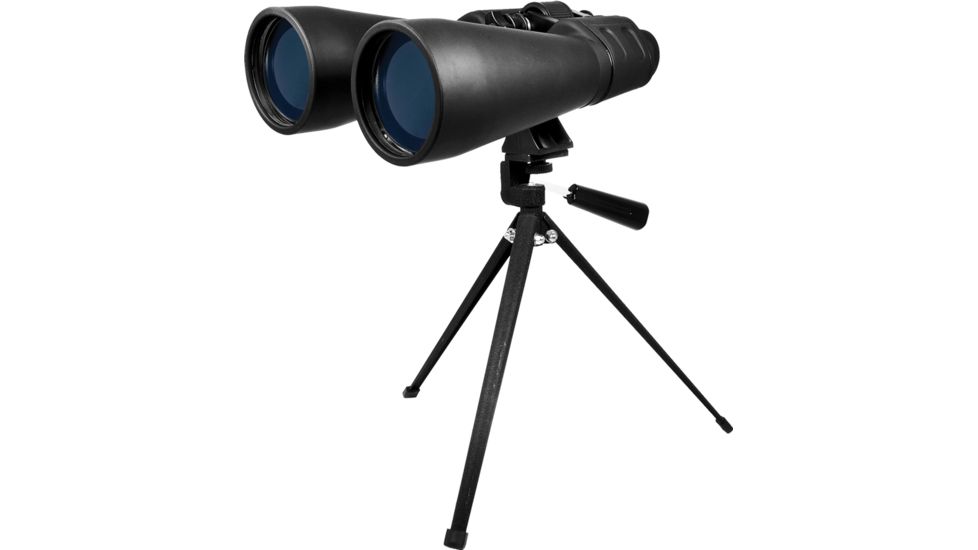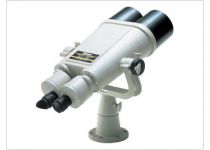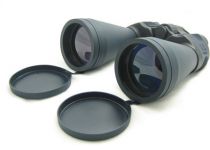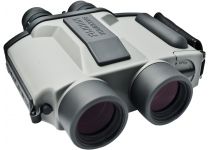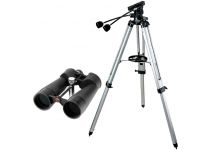If your main interest in astronomy is exploring the fine details of planets or showing structure in distant galaxies, astronomy binoculars are not for you - they just don't have enough magnification. However, if you thrive on large open star clusters and big, extended nebulae, a binocular can actually be more effective than a telescope. In fact, a binocular is one of the best "first telescopes" you can buy, and even an experienced pro usually keeps one by their telescope.![]()
What Binocular Prism Type Is Best for Stargazing?
- Porro prism binoculars, with their superior light transmission (no mirrored surfaces) and inherent image sharpness (no phase-shift) rule the roost here. There are a few 9x63 roof prisms floating around the market from time to time, but unless they are PC roof prisms, they will not be as sharp as the same size in a porro prism.
- Bak-4 glass is the preferred glass for a porro prism bino and will deliver brighter, sharper images than inexpensive BK7 prisms. All but the cheapest astronomy binoculars will have the superior Bak-4 glass.
What Do the Numbers on a Binocular Mean?
Magnification Is the First Number on a Binocular
For astronomy, the magnification you select should reflect the way you intend to use it. A handheld binocular is a relaxing and inexpensive way to enjoy astronomy. Setup time is zilch, and there are no accessories to drain the pocketbook. If you plan to use this method, you should keep the magnification below 12x to maintain steadiness. However, when combined with enough objective size, a 7x to 12x binocular will show you hundreds of star clusters, nebulae, and even some galaxies. Putting a binocular on a tripod or mount pushes the binocular into the telescope realm as far as operation goes, but it is the only way to handle magnifications over 15-20x effectively. A 15x-30x binocular will show more detail and resolve more stars. Though, it still won't turn your binocular into a telescope for observing planets. Still, there is nothing like the view in a 25x100mm binocular to take your breath away on a dark, clear night.
Objective Lens Is the Second Number on a Binocular
Any binocular with an exit pupil (objective divided by magnification) of 5 or more can be used for stargazing. Thus, you may already own an 8x40 or 10x50 that will serve you well. A 7x50 bino may reveal fainter stars under ideal conditions, but the difference will rarely be enough to add more objects to your list. On the other hand, if you are going to buy an astronomy binocular anyway and don't want to mess with a tripod, the 7x50 is a classic. It's lost some of its status in recent years to the giants, but it is still unbeatable for viewing really extended open clusters and nebulae. As far as stargazing binoculars go, nothing is easier to use than a 7x50. Larger objective lenses reveal fainter stars and/or more detail.
Binoculars with objectives of 60mm or more are called giant binoculars, and rightfully so. You can handhold a 10x70 or even an 11x80 for short periods of time by grasping them around the barrels near the objectives. A 10x70 or 11x80 will add a little more detail to what you can see in a 7x50 and maintain the same image brightness as well. For a handheld binocular, a 10x70 or 11x80 represent the upper limit of practical. Indeed, most observers prefer to put this size binocular on a tripod for long observing sessions. When you combine magnifications over 15x or so and objectives of 80mm or more, you are using binoculars that can rival and exceed the view in a small telescopes for certain types of objects and do it with the comfort of two eyes. The only real limit on most giant binoculars is their fixed magnification, though a few models are now appearing that offer interchangeable eyepieces.
How to Choose an Astronomy Binocular Mount
Choosing the best mount for your astronomy binocular is very important.
- If you plan to use a binocular with more magnification than 10 or 12x and/or objective lenses of 70mm or more, you will need a mount of some type. Big binoculars need big mounts. A large, heavy-duty camera or video tripod will work for 80mm and some 100mm binos - if the head has no slop when it is locked down. Nothing is more aggravating than finding your target, centering it in your field of view (FOV), and locking the tripod head, only to watch the target disappear from the FOV because the giant astronomy binocular sags in the mount when you let go. The really heavy stuff is best supported by something more permanent.
- For a binocular that will be mounted on a tripod, be sure to compare the weight of the binocular with the maximum load capacity of the tripod, if listed. Unfortunately, this number is not standardized, nor will it guarantee how well it will work with a large binocular, but it is a place to start. For an 80mm binocular, look for a binocular tripod that lists a capacity of at least 12lb, although 15lb or more is better.
- Another spec to check is the actual weight of the tripod. If the tripod only weighs three or four pounds, it will struggle when loaded with a binocular of equal weight. Again, bigger is better because portabilty is rarely an issue.
- One useful trick is to sit rather than stand when using a binocular on a tripod. This increases stability because the binocular doesn't need to be mounted so high.
- Lastly, quick-release (QR) plates are a convenient feature, but if they fit loosely in the tripod head, they will introduce some unwanted sag in the mount. If you are going cheap, it's better to go with a model without QR plates.
Finding the Best Focus Type and Binocular for the Money
Individual Eyepiece Focus or Center Focus?
Close focus is obviously not a factor for astronomy, but if you plan to use your astro binocular by day, you will discover that most giant binoculars are poor in the close focus department. Both IF (individual eyepiece focus) and CF (center-focus) are used in astronomy binoculars. IF is a practical system since there is little in the way of focusing when using a binocular for astronomy. An IF focusing binocular has fewer moving parts and is also easier to seal against dust and moisture. Center focus binoculars are easier to use when there is a need to refocus a lot, as you might when sharing a binocular with others. It is also the most versatile if you plan to use your binocular for applications other than astronomy.
How Much Should You Pay for a Quality Astronomy Binocular?
The majority of giant binoculars these days are made in China. This is not necessarily bad, as Chinese optics can be made to very high optical standards. Some popular brands here include Oberwerk (lots of nice features, including collimation screws), Celestron binoculars,and Meade binos. All of these offer tremendous optics for the dollar and bring a giant binocular within reach of any budget. Most 80mm binoculars here will run between $100-$300, with 100mm models starting at about $400 and running over $1000 for deluxe models with interchangeable eyepieces and pier-mounting options. The best of the giant astronomy binoculars, though, are still made in Japan. These are not cheap. They include Fujinon (everything from a 70mm to pier mounted telescopes), Kowa observation binos (available in fluorite), and the superb Nikon Binocular line. All of these will provide a lifetime of sensational viewing. They are considered to be the finest optical instruments of their type.
How to Choose Eye Relief, Lens Coating & Weight
Eye relief is a critical feature, since many big astronomy binoculars have poor eye relief and will not provide a full field of view when you wear glasses. In general, the higher the magnification, the worse the eye relief is likely to be.
There is no excuse for going with anything less than an FMC (fully multi-coated) binocular for astronomy. With multi-coating now featured on even economy-grade binoculars, any serious astronomy binocular will have this feature.
With the weight of a handheld binocular, a cushioned strap or binocular harness recommended. For an astronomy binocular that will be mounted on a tripod, see the section above on binocular mounts.
Also, an astronomy binocular doesn't need to be waterproof, but it helps. Observing at night frequently exposes a binocular to dew and moisture, which can cause a non-waterproof model to leak. We sell several models of waterproof binoculars to ensure premium viewing in any conditions.



